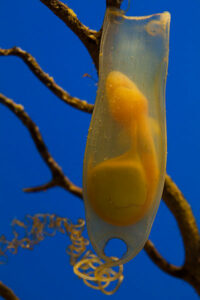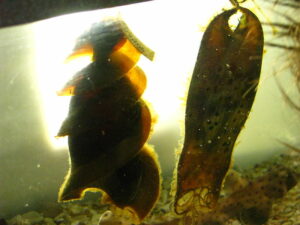Amniotes are animals that protect their embryos in a covering of thick membranes. They either lay eggs on land or retain embryos within the body to lay eggs in water.
Amniotic eggs are not found in sharks. Sharks, in other words, are not amniotes. There are two types of sharks: those that release eggs and those that produce live young. However, whale sharks are different. Whale sharks generate eggs that develop inside their bodies, followed by which they give birth to baby whale sharks.
Shark eggs lack the amnion, the membrane, and they lay eggs in water to survive. That said, around 70% are viviparous (deliver their young). Only about a third of them are oviparous, which means they lay eggs.
With this in mind, we’ll go over the shark reproduction mechanism and variations in great depth. Stick with us till the end to learn more on the topic.

What are Ovoviviparity sharks?
Although sharks are broadly categorized as oviparous and viviparous, there is another category. This category is called ovoviviparous.
Sharks classified as ovoviviparous do not lay eggs outside until the embryo has absorbed the yolk sacs, matured, and hatched. Females maintain the eggs inside their bodies until the last stage, after which they deliver live offspring that look like minuscule sharks.
Sharks that form in egg cases have a similar reproductive process with the only difference being that the eggs are hatched outside in the free-flow water. Here, it’s important to understand this is the most prevalent sort of shark development.
Shark species like whale sharks, basking sharks, dogfish sharks, and angel sharks are some that fall under the ovoviviparous category.
Do sharks lay eggs?
Sharks are fascinating creatures and also one of the most ancient ones on this planet. Their reproductive strategies are unique. It is pretty intriguing to explore if they lay eggs.
Only a few shark species (between 30% and 40%) lay eggs, and they are known as oviparous sharks. It’s, however, worth noting that the majority of sharks give birth to their young (viviparous) instead of laying eggs. Some of the shark species that lay eggs in water are the small-spotted catshark, and nursehound.
Experts have found that sharks lay eggs that are kept protected in an egg case and tendrils, which is often known as the “mermaid’s purse”. It could take several months for shark eggs to fully develop.

In some cases, however, the eggs remain inside the female shark’s body until she lays them. This method permits the embryo to develop more thoroughly and completely before hatching.
Which sharks lay eggs?
The number of sharks that lay eggs is lesser than the ones that give birth to their young. So, which sharks species belong to the category of oviparous?
The shark species that reproduce via laying eggs include:
- Small-spotted catsharks
- Coral catsharks
- Finback catsharks
- Wobbegong sharks
- Bamboo sharks
- Swell sharks
- Bullhead (horned) sharks
- Lesser-spotted dogfish
- Chain dogfish
- Nursehound

Juvenile brown-banded bamboo shark by
Steve Childs (CC BY 2.0) from Wikimedia
Here, it is interesting to note that, although most shark eggs are covered in a rectangular egg case, the egg cases of bullhead sharks are cylindrical. These egg cases also feature corkscrew-like ridges on the outside.
How many eggs do sharks lay?
Not all sharks lay eggs. But the ones that do are known as oviparous, and their numbers are pretty less than viviparous sharks.
There are no specific numbers to state how many eggs can a shark lay. However, the usual numbers are not as high as other fish species. That said, some shark species can lay 1- 4 eggs while others may lay much more than that.
How many eggs do sharks lay at a time?
Around 30-40% of all species of shark are oviparous, meaning they lay eggs. However, how many eggs can a shark lay at a time is something fascinating to learn?
There is no definitive statistic for how many eggs a shark can lay at any given moment. This number varies by species and can range from one to over twenty at a time.
How many eggs do sharks lay in a year?
Sharks classified as oviparous lay eggs to reproduce. Although oviparous sharks are rare, the number of eggs they lay in a year is worth investigating.
The number of eggs laid by a shark in a year is determined by its species. There does not exist any specific number. Sharks like the lesser spotted dogfish, on the other hand, have been observed to lay up to 20 eggs every year.
Do whale sharks lay eggs?
Whale sharks are the world’s largest fish. It is not only their appearance that fascinates us but also their reproductive patterns.
Whale sharks do not lay eggs but they produce them. To put it another way, female whale sharks are ovoviviparous, meaning they carry their eggs inside their bodies until they hatch. These sharks then give birth to their live young once the eggs hatch. This was discovered after a pregnant whale shark was taken off the coast of Taiwan in 1995.
Whale sharks’ reproductive strategy is not only prevalent within them but also in most shark species, including great white sharks, tiger sharks, shortfin mako sharks, and basking sharks.
Do tiger sharks lay eggs?
Tiger sharks are well known for their ferocity. These sharks use internal fertilization to reproduce. But how do they give birth?
Tiger sharks are not viviparous, however, they do give birth to pups. It implies that tiger sharks do not carry children in their wombs. Instead, they lay eggs and carry them inside their bodies until the embryos mature and hatch. Female tiger sharks afterward give birth to young pups or small live sharks.
It’s worth noting that a female tiger shark can give birth to more than 30 to 35 pups at a time. The baby tiger sharks are already active predators after birth, feeding on coastal fish and crustaceans.
Do great white sharks lay eggs?
One of the most fierce shark species in the marine world is the great white. But how do they give birth? Let’s explore.
Great white sharks are ovoviviparous, meaning they lay eggs inside their bodies rather than outside. Once the eggs have developed and hatched, these sharks give birth to live pups. A great white shark can give birth to 2- 10 baby sharks at a time.
One of the most fascinating facts about white shark reproduction is that the developing shark pup will feed on the egg sacs inside the female’s body. Oophagy is the term for this type of feeding. In truth, white sharks, like many others, are known to produce a huge number of unfertilized eggs, with only the strongest surviving to be born.
Do hammerhead sharks lay eggs?
One of the weirdest looking sharks out there is a hammerhead shark. After the male delivers seed to the female through claspers, these sharks become internally fertilized.
Hammerhead sharks are not viviparous and do not produce eggs. Instead, hammerheads are viviparous, indicating they deliver living young. Hammerheads normally only spawn once a year, in the spring and summer, and each litter produces 12 to 15 pups. Great hammerhead sharks, on the other hand, can have 20 to 40 pups every litter.
Although hammerhead sharks reproduce through proper breeding, bonnethead sharks are capable of parthenogenesis.
Do bull sharks lay eggs?
Bull sharks are extremely dangerous. They are, nonetheless, fascinating, and scientists can learn a lot about them by analyzing their reproductive behavior.
Bull sharks are viviparous, which means they don’t lay eggs. Live young are born to these sharks. These sharks conceive after breeding in the late summer or fall months and carry the developing embryos inside their bodies to be fed by a yolk-sac instead of a placenta. After an 11-month gestation cycle, female bull sharks give birth to 1- 13 young pups.
Bull sharks like to give birth near estuaries, coastal lagoons, and river mouths in freshwater ecosystems.
Do zebra sharks lay eggs?
We mentioned sharks reproducing in a parthenogenesis, in one of the previous sections. Zebra sharks are one of the shark species that may reproduce without the help of a male.
Zebra sharks are known to lay eggs. Although certain zebra sharks have been shown to spawn by parthenogenesis, female zebra sharks in the wild are impregnated by male sharks. Female zebra sharks produce eggs in their bodies and then lay those eggs on the ocean floor. These sharks can lay anywhere from 1 to 4 eggs at a time.
Do rainbow sharks lay eggs?
In captivity, rainbow sharks have never been bred. Experts investigated them in the wild to figure out how they reproduce.
Rainbow sharks are oviparous sharks, which means that they lay eggs. Male sharks spray on the eggs after they are laid, fertilizing them. To put it another way, we can say that the eggs of rainbow sharks are fertilized outside of the mother’s body.
Did megalodon sharks lay eggs?
The erstwhile apex predators of the waters have a plethora of secrets that specialists are still unraveling. Their reproduction strategy is one of those mysterious traits.
To date, every study on megalodons has indicated that these sharks give birth to live pups. What’s even more remarkable is the fact that these sharks gave birth to pups that were up to 6.5 feet long. And scientists attribute megalodon pups’ size to uterine cannibalism, in which the strongest pup feeds on unfertilized eggs in the mother’s womb.
Summary
So, with this we have come to the end of our post. And by now, it is a clear fact that sharks do not lay amniotic eggs. Their reproductive techniques, on the other hand, can be divided into three categories: oviparity, viviparity, and ovoviviparity. Also, certain shark species do not need a male to get impregnated, as they reproduce via parthenogenesis. We hope that this article has given you some insight into how various sharks reproduce. If you liked it, don’t fail to tell your friends about it.




